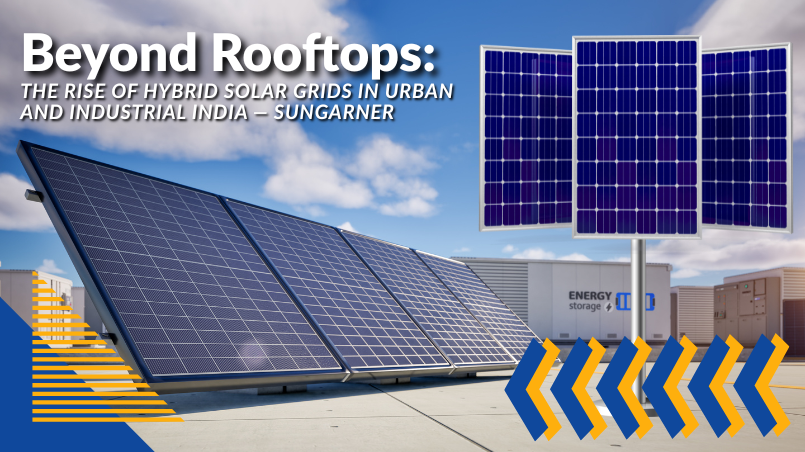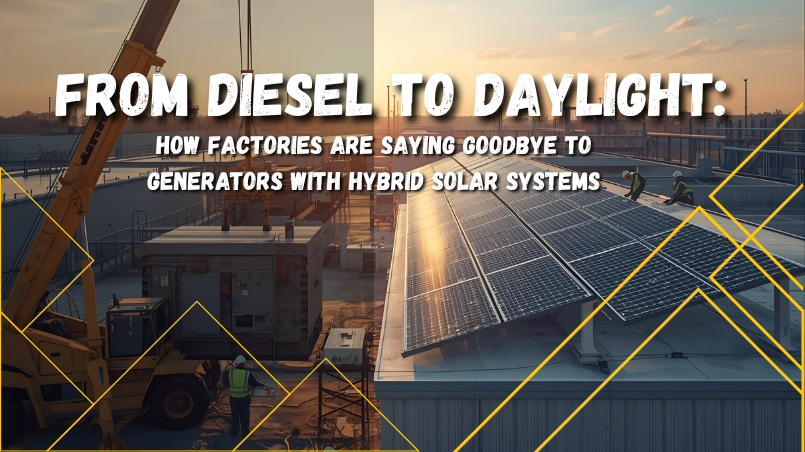Beyond Rooftops: The Rise of Hybrid Solar Grids in Urban and Industrial India -SunGarner
A hybrid solar grid integrates solar panels, battery storage, and traditional grid power to create a balanced energy ecosystem. Unlike standalone rooftop solar setups that only generate power during daylight, hybrid systems store excess energy and use it later—ensuring uninterrupted supply during nights or outages....
For years, rooftop solar panels have symbolized India’s clean energy movement — sleek, efficient, and empowering homeowners and businesses alike. But as power demands surge and energy reliability becomes mission-critical, a new chapter is unfolding — hybrid solar grids.
These advanced systems combine solar energy with battery storage and grid connectivity, offering a seamless, 24/7 power solution. At SunGarner, we’re witnessing how hybrid solar systems are redefining urban and industrial energy infrastructure across India in 2025 and beyond.
What Are Hybrid Solar Grids?
A hybrid solar grid integrates solar panels, battery storage, and traditional grid power to create a balanced energy ecosystem. Unlike standalone rooftop solar setups that only generate power during daylight, hybrid systems store excess energy and use it later—ensuring uninterrupted supply during nights or outages.
In simple terms, hybrid solar grids give solar power a steady heartbeat, allowing factories, offices, and urban infrastructure to stay powered 24/7.
Why Hybrid Solar Systems Are Gaining Momentum in India
India’s renewable revolution has been remarkable — with over 75 GW of solar capacity installed and an ambitious goal of 280 GW by 2030. Yet, grid instability, rising tariffs, and demand fluctuations are pushing industries and cities toward hybrid solar solutions.
Here’s what’s driving this transformation:
Reliability Over Intermittency: Solar energy is clean but inconsistent. By pairing panels with advanced lithium-ion or sodium-ion batteries, hybrid grids ensure a continuous power flow, even during cloudy days or at night.
Rising Industrial Power Needs: Industrial zones, data centers, and manufacturing hubs are turning to hybrid solar systems to reduce grid dependency, cut energy costs, and maintain round-the-clock operations.
Smart Energy Management: Modern hybrid setups use AI-powered solar inverters and energy management systems (EMS) that balance loads, optimize storage, and automatically select the most cost-effective power source.
Government Incentives: The MNRE (Ministry of New and Renewable Energy) supports hybrid projects through subsidies, financing schemes, and initiatives like PM-KUSUM and Green Energy Corridor, accelerating large-scale adoption.
How Hybrid Solar Grids Work
The functioning of a hybrid solar system is intelligent yet simple:
1. Solar Generation: Panels convert sunlight into electricity.
2. Battery Storage: Excess power is stored for later use.
3. Grid Integration: The system synchronizes with the main grid for backup or power export.
4. Energy Management: AI-based controllers balance power between solar, storage, and grid sources.
This creates a self-sustaining energy loop, delivering reliability, efficiency, and savings—essential for high-demand environments.
Best Practices in Hybrid Solar Deployment
At SunGarner, we follow globally recognized best practices to ensure performance and longevity of hybrid solar grids:
* Accurate Load Analysis: To size systems correctly and avoid underperformance.
* Use of Tier-1 Components: Premium solar modules, inverters, and battery packs ensure durability.
* Smart Monitoring: IoT-based dashboards track system performance in real-time.
* Scheduled Maintenance: Preventive checks keep systems running at peak efficiency.
* Integration with EMS: Enables predictive analytics and energy optimization.
These practices help maximize ROI while minimizing downtime — crucial for industries with high operational sensitivity.
Trends Defining Hybrid Solar in 2025
The hybrid solar market in India is evolving faster than ever. Here’s what’s shaping its growth in 2025:
1. Affordable Energy Storage: Battery prices have dropped by nearly 25% since 2020, making hybrid systems more cost-effective for both SMEs and large enterprises.
2. Shared Microgrids: Industrial clusters are adopting shared hybrid microgrids — centralized systems that distribute clean power to multiple facilities within one estate.
3. Urban Integration: Hybrid solar is powering EV charging stations, metro depots, and smart buildings, driving India’s urban modernization efforts.
4. ESG & Sustainability Goals: Businesses are investing in hybrid solar to achieve carbon neutrality and meet ESG benchmarks, aligning with global sustainability standards.
5. Hybrid-as-a-Service Models: Solar providers like SunGarner are offering leasing and PPA-based models, allowing businesses to access clean power without heavy upfront investment.
Market Insights: The Indian Opportunity
Analysts project the hybrid solar market in India to grow at a CAGR of over 10% from 2024–2030. States like Maharashtra, Gujarat, and Tamil Nadu are leading adoption due to strong industrial bases and favorable policies.
As one of India’s trusted clean energy innovators, SunGarner is driving this revolution — delivering custom-built hybrid solar solutions that combine innovation, reliability, and sustainability.
Conclusion
The shift beyond rooftops marks a turning point in India’s renewable journey. Hybrid solar grids are not just an upgrade — they’re the foundation of a resilient, green future.
At SunGarner, we’re committed to helping businesses and cities transition toward smart, uninterrupted, and eco-efficient energy systems that power progress sustainably.
Power your growth with SunGarner — where innovation meets clean energy. Connect with us today to explore customized hybrid solar solutions for your business.
Frequently Asked Questions (FAQs)
1. What makes hybrid solar grids better than traditional rooftop systems?
Ans: Hybrid systems combine solar energy, battery backup, and grid connectivity to provide continuous power, while rooftop systems rely only on sunlight and stop generating at night or during outages.
2. Can hybrid solar systems work in both urban and industrial setups?
Ans: Yes. Hybrid solar grids are ideal for urban homes, commercial buildings, and industrial zones, offering scalable energy solutions tailored to varied power needs.
3. How much can industries save using hybrid solar systems?
Ans: Depending on load and energy usage, industries can reduce energy bills by 30–50% while minimizing grid dependency and carbon emissions.
4. What kind of batteries are used in hybrid solar systems?
Ans: Most systems use lithium-ion batteries, but newer technologies like sodium-ion and flow batteries are gaining popularity for longer life and better scalability.
5. Does SunGarner offer customized hybrid solar solutions?
Ans: Absolutely! SunGarner specializes in custom-designed hybrid solar grids for residential, commercial, and industrial applications—ensuring optimized performance, energy savings, and sustainability.









